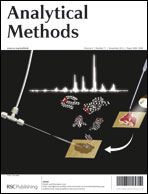Summary: Horseradish peroxidase (HRP) multimer on a graphene modified glassy carbon electrode (GCE) has been fabricated by carbodiimide coupling reaction. The possible adsorption sites of HRP on graphene were predicted by Lamarckian genetic algorithm. It has been observed that HRP has five possible sites for its adsorption to graphene. Scanning electron microscopy and atomic force microscopy measurements support the evidence of formation of HRP multimer graphene. The graphene–HRP multimer film showed good electrocatalytic activity for the reduction of hydrogen peroxide. The electrochemical studies showed that graphene on the GCE increased the effective surface area, reduced the charge transfer resistance of the electrode and enhanced the electrochemical signal. The detection limit of H2O2 (9 nM) at graphene–HRP multimer was also lower than that of other electrodes studied in this work. The sensitivity of the graphene–HRP multimer film towards H2O2 determination was 7.8 μA μM−1 cm−2. Differential pulse voltammetry and selectivity studies revealed that GCE modified by graphene–HRP multimer film can be efficiently used for H2O2 determination in real samples.
Graphene impregnated with horseradish peroxidase multimer for the determination of hydrogen peroxide
